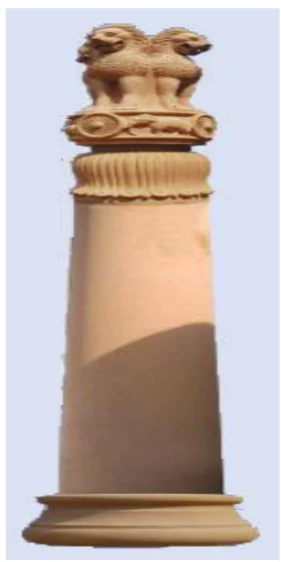Introduction
Mauryan architecture was influenced by Buddhism and Jainism. It was divided into court art and popular art based on the presence or absence of state patronage.
Royal Court Arts: Palaces, Pillars, and Symbolism in Ancient India
It includes the architectural works commissioned by rulers. It was used for political as well as religious purposes.
- The Magnificent Palaces of Ancient India
- Wooden Structure: Ashoka’s Palace at Kumrahar was a three-storey massive wooden structure with a high central pillar.
 Inspiration: The Palace of Chandragupta Maurya was inspired by the Achaemenid palaces at Persepolis in Iran.
Inspiration: The Palace of Chandragupta Maurya was inspired by the Achaemenid palaces at Persepolis in Iran.
- As per Megasthenes, it was one of the greatest creations of mankind.
- Pillars of Power: Ashoka’s Monuments and Their Symbolic Significance
- Ashoka’s pillar inscriptions were built as a symbol of the state and to commemorate battle victories.
- The pillars were usually made of Chunar sandstone.
- The pillar is made up of four parts:
- Shaft: The shaft formed the base and was made up of a single piece of stone or monolith.
- Capital: It lays above the shaft and could be either lotus-shaped or bell-shaped. The bell-shaped pillars, influenced by Iranian pillars, are known for their lustrous and polished finish.
- Abacus: On the top of the capital, there was a circular or rectangular base known as the Abacus on which animal figures were placed.
- Capital Figure: They are usually figures of animals like bull, lion, elephant etc.
- Examples: Some of the existing pillars with capital figures were found at Basarah-Bakhira, Lauriya Nandangarh and Rampurva (Bull) in Bihar, Sankisa and Sarnath (Lion) in Uttar Pradesh.
Enroll now for UPSC Online Course
National Emblem
- Lion Capital: The abacus and the lion capital part of the Sarnath pillar form the official National Emblem.
- Animal Figures: In the abacus of the Sarnath pillar, four animals represent four directions – a horse (West), an elephant (East), a bull (South) and a lion (North). The abacus has the depiction of a chakra (wheel) having twenty-four spokes in all the four directions.
- The Elephant depicts the dream of Queen Maya, the Bull depicts the zodiac sign of the month in which Buddha was born (Taurus), the horse represents the Buddha’s horse Kanthaka which he used for going away from princely life, and the lion shows the attainment of enlightenment.
- This pillar capital was built by Ashoka commemorating Dharmachakrapravartana (the first sermon by the Buddha).
- The four lion symbols symbolise Buddha spreading Dhamma in all directions.
- Satyamev Jayate: In the National Emblem, the words Satyameva Jayate from Mundaka Upanishad, meaning, “Truth alone triumphs”, are inscribed below the abacus in Devanagari script.
|
Enroll now for UPSC Online Classes
DIFFERENCES BETWEEN ASHOKAN AND ACHAEMENIAN PILLARS
| ASPECT |
ASHOKAN PILLAR |
ACHAMENIAN PILLAR |
| Period |
|
|
| Purpose |
|
|
| Material |
- Sandstone or other local stone
|
- Limestone, sandstone or other local stones
|
| Structure |
- Single monolithic shaft with a capital.
|
- Tall, fluted shaft with elaborate capital and made up of several stones cemented together.
|
| Religious influence |
- Associated with Buddhism.
|
- Associated with Zoroastrianism and Persian culture.
|
| Capitals |
- Sculptures of lions, elephants and bulls.
|
- No capitals, only images of humans are engraved on shafts.
|
Conclusion
- Court arts serve as invaluable records of historical narratives, offering insights into the tastes, values, and power dynamics of royal courts across civilizations.
- Their preservation is essential for understanding our collective heritage.
![]() June 7, 2024
June 7, 2024
![]() 3816
3816
![]() 0
0
 Inspiration: The Palace of Chandragupta Maurya was inspired by the Achaemenid palaces at Persepolis in Iran.
Inspiration: The Palace of Chandragupta Maurya was inspired by the Achaemenid palaces at Persepolis in Iran.